Milk and Draught breeds – Indigenous Breeds
Dual Purpose Breeds – Indian Cow Breed
Draught Plus Milk Breed
The cows in these breeds are average milk yield and male are very useful for work. Their milk production per lactation is 500 kg to 150 kg. The example of this group is Ongole, Hariana, Kankrej, Tharparkar, Krishna valley, Rathi and Goalo Mewathi.
Haryana Cow Breed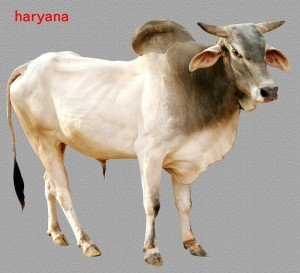
As the name suggests, Hariana cows are found in Haryana/UP areas.
This breed is one of the most distinguished and dual-purpose breeds of North India and one of its main uses is in the production of high-quality Bull.
Mainly found in Karnal, Hisar and Gurgaon district of Haryana, Delhi and Western M.P. The breed is also reared in the states of Rohtak, Haryana, Hissar, Jeend and Gurgaon.
Apart from the above places, Haryana is found abundantly in Alwar, Jodhpur, Loharu & Bharatpur states of Rajasthan India. In UP it is found near and around states of Meerut, Muzaffarnagar, Bulland Shahar, Aligarh and Bijnaur. A pure and Ascendant form of this breed is prominently seen in certain areas of Rajasthan like Jhajjar, Beri & Jahajgarh.
It is a famous & well-known breed in Ganga’s Doab. ( The Doab, unqualified by the names of any rivers, designates the flat alluvial tract between the Ganges and Yamuna rivers in western and southwestern Uttar Pradesh and Uttarakhand state in India, extending from the Sivalik Hills to the two rivers’ confluence at Allahabad. The region has an area of about 23, 360 square miles (60, 500 square km); it is approximately 500 miles (805 km) in length and 60 miles (97 km) in width.
Doab figures prominently in history and myths of Vedic period; the epic Mahabharata, for example, is set in the Doab, around the city of Hastinapur”
Haryana Cow Breed – Physical Characteristics :
• White or light Grey Skin Color.
• In Bulls, Front and posterior part is Dark.
• Long and thin face.
• Muzzle / Nose is always Black.
• The forehead is flat, Horns are small, sharp and rounded towards the inside, eyes are black and attractive.
• In certain breeds, eye’s iris is black too.
• Head is erect and high which gives them an extinguished personality.
• Hump is seen in both male and female breeds and is more prominent in the male breed as compared to Females w.r.t to the rest of the body.
• Hoof is black, legs are shapely, attractive and long
• The udder is capacious and extends well forward with a well-developed milk-vein. Milk glands are medium sized and well developed
• A tail is rather short, thin and bent
• Adult body weight is around 499 and 325 kg in males and females respectively.
• Lactation length is about 272 days ranging from 238 to 330 days. Average service period is 232 days (range 126 to 305 days), dry period 255 days (range 133 to 571 days) and calving interval 483 days (range 415 to 561 days).
Tharparkar Cow Breed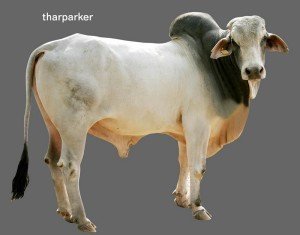
Dakshini Sindh (Pakistan’s) Tharparkar sector is the producer of this cow. This breed is visible from the west region of Rajasthan at Indo Pak Border to Kuchh of Gujarat. The development of this breed of cow is the result of atmospheric conditions of Rajasthan’s Thar Desert and similar areas. Mainly found in Jodhpur, Kutch and Jaisalmer
Tharparkar Cow – Physical Characteristics
• Skin Color – White / light Grey.
• Face & Rest of the body parts are dark.
• Bulls / male cows have curly hair above the forehead.
• Flat forehead, Broad and Elevated over the eyes .
• Horns and face are at the same level.
• In Bulls, the higher part of forehead is more protruded.
• Face is bent, clear and little rounded
• Jaw is very strong and eyes are serene, calm and serious.
• Ears are long, broad and little bent.
• Tharparkar cows breed calve for the first time at an average age of about 1, 247 days (range 1, 116 to 1, 596 days), milk yield is 1, 749 kg (range 913 to 2, 14.7 kg) and calving interval 431 days (range 408 to 572 days)
• Fat content in its milk is 4.9%.
• Milk yield – Under village condition :1660 kg
• Milk yield – Under commercial farms: 2500 kg
Kankrej Cow Breed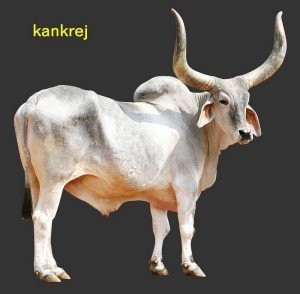
Kankrej cattle are one of the most well-known & amongst the largest cattle of India and are prized as powerful draft animals.
It has played an important role in preserving the cow race in the USA thus heavily impacting U.S. cattle breeding. They are moderate milk producers. This is a very simple race of cows which adjusts itself to the worst of condition; these cows are very peaceful in nature and in their movement and manner of living.
Kankrej cattle are maintained as a pure breed in India and Brazil in large numbers, with a few in the U. S. They are fertile under adverse conditions.
Kankrej Cow Breed – Physical Characteristics:
• Kankrej cattle are gray cattle of northern India with big, long and round horns.
• Bulls are comparatively darker in color then the rest of the breed.
• Having small but broad faces with long ears drooping and open to the front.
• Color varies from light gray to black at maturity.
• Age at first calving -36 to 42 months
• Calving interval – 15 to 16 months
• Lactation length averages 294 days (range 257 to 350 days)
• Milk yield – Under village condition :1300 kg
• Milk yield– Under commercial farms : 3600 kg
• Fat is around 4.8% (range 4.66 to 4.99%).
• Bullocks are fast, active and strong. Good for plough and cart purpose
Upgrading Indigenous cattle of India
| Breed | Habitat/Main State | Breeding Tract Districts | Assembling Center | Areas of demand | Remarks |
| Hallikar | Karnataka | Tumkur, Hassan & Mysore | Dodbalapur, Chickballapur, Harikar, Devargudda, Chikkuvalli, Karuvalli, Chittavadgi (T.N.) North Arcot (T.N.) Hindupur, Somaghatta, Anantapur (A.P.) | Dharwar, North Kanara, Bellary (KT) Anantur & Chittur (A.P.), Coimbatore North Arcot, Salem (T.N.) | Draught breed |
| Kangayam | Tamil Nadu | Erode | Avanashi, Tiruppur, Kannauram, Madurai Athicombu | Southern Districts of Tamil Nadu | Draught breed |
| Red Sindhi | Pakistan All parts of India | – | – | – | Dairy breed |
| Tharparkar | Pakistan(Sindh) | Umarkot, Naukot, Dhoro Naro Chor | Balotra (Jodhpur), Puskar (Ajmer), Gujarat State | – | Dairy breed |
| Vechur | Kerala | – | Vaikom, Mannuthy (Kerala State) | – | – |
(Source: National Dairy Development Board)

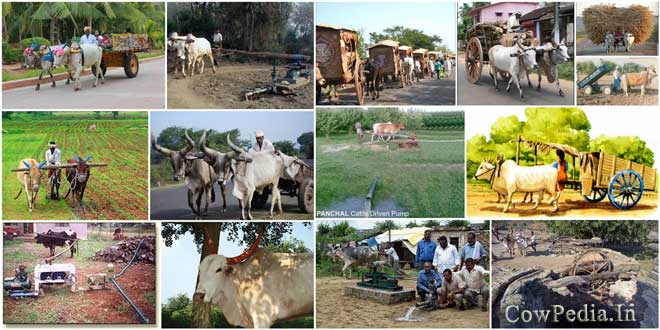


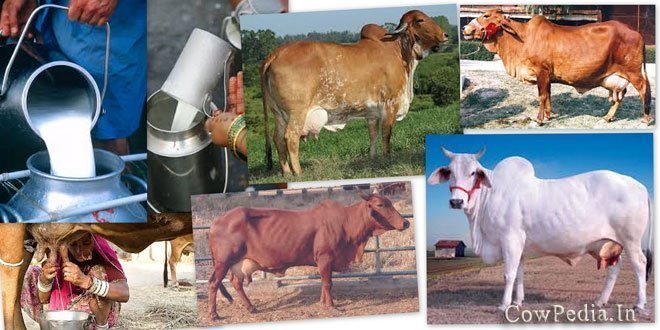
Leave a Reply
Want to join the discussion?Feel free to contribute!